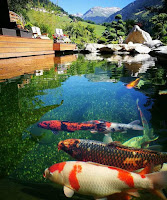- Koi Dealers
- Health
- Appearance
- Price
Koi Dealers
The dealer you buy from Koi must have a clean object. A dealer can have a much higher population density than an amateur, since he keeps Koi will not be there for a long period of time. The tanks in which the Koi is housed should not be filled, and they should either be placed a few feet apart, or there must be a barrier between them. If your dealer has a shipment under quarantine, you do not want to purchase Koi from a reservoir that can potentially be assembled. The water into which the fish got caught must be clean with adequate filtration to support the heavy load on the fish.The dealer must carry out quarantine and perform viral tests on each of his shipments. Avoid any dealers who ship the cargo to Koi, and then immediately offer them for sale.
Health
Koi, to whom you look, should be healthy. He should show normal behavior. If you notice that the Koi flash (by scratching yourself on the side of the tank) avoids this, it may have a problem with the parasite. Look at Koi for any visible parasites and ulcers. Inspect another Koi from the dealer, if you notice a lot of health problems with your fish, you can go somewhere else.
Appearance
Select the Koi fish:
Body conformation
The body of the fish Koi must be symmetrical, without physical deformations. Women Koi is preferable to men, because of their body shape, when they mature. A mature female has a large body that has a shape resembling an airship. A mature man will have the shape of a cigar.
Skin gloss
Skin condition strongly affects the appearance of the color. If Koi is sick, malnourished, or if he is in a bad environment, the quality of the skin suffers along with the color.
Color Quality
The color should be even throughout the fish. If you were looking at Kohaku, you would not want the red spots to be darker than the others. Keep in mind that the color on the head will look different on the body, as it will not extend to the scale. Inspect Koi for any colour loss. It will be a patch or part that will look faded. Colours should be strong, for example, white should be bright, without yellowing.
Border
It is necessary to define the border of the colour template. Blurred edges will look worse as Koi grows.
Colour scheme
The colour should be evenly distributed over the upper body of the fish. Kohaku with red patterns towards the back of the fish will look less impressive than one with a stepping pattern on the back.
Price
Most small Koi have a fixed price. Larger Koi are calculated on an individual basis. Japanese Koi adorn the highest prices. They are the winners of the show, and they retain their colour because of the strict rules of reproduction. Most domestic (US divorced) And imported (Malaysia, Indonesia, China, etc.) Pisces Koi are readily available, but often remain small and lose their colour. Be careful with the dealers who try to sell you Koi with inflated prices. Often, they will designate Koi as "imported", or they will sell domestic Koi with "Japanese parents" to "improve" the value of their Koi. Any dealer worthy of his salt will know the source of his Koi.
(Go back to Koi care)














